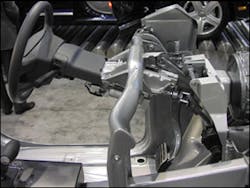As a rescue responder, we almost always find that the vehicle we are about to rip apart to free trapped patients is a front wheel-drive.
As a rescue responder, we almost always find that the vehicle we are about to rip apart to free trapped patients is a front wheel-drive. Since the 1980 model-year, front wheel-drive has become the standard design for almost all sedans we encounter today.
What is important for extrication personnel to know about the design of the system that steers a front wheel-drive vehicle? It's the rack-and-pinion steering system. Despite what rescue instructors first taught in the early years of rack-and-pinion, the steering column acts in a very predictable manner during extrication work.
As shown in this image, a rack-and-pinion steering column is actually several sections of steel connected together through knuckle joints. The leading end of the front section is within the engine compartment. This section is the pinion which connects to the grooves in the steering linkage assembly known as the rack.
The rescue concern with rack-and-pinion steering is that as the column moves during a dash roll or when jacking the dash, the various sections don't always move together. One section may shift to the inside while the section below it moves upward and so on.
For safety sake, make sure the member operating the rescue tool that is causing the steering column to move is not only watching the 'action' end of the job but is also watching the 'reaction' end of the column as well. The action end of the steering column is typically the steering wheel end. That upper section moves away from the trapped patient if the job is going as planned. The reaction end is the lowest section of the column, the section right at the floorboard. It may be contained inside a rubber boot to conceal it from view of occupants inside the vehicle.
As the dash moves, the sections of the column move also. Be especially alert to watch the lower sections. Usually the steering column will move far enough to free the driver before the two lower sections of the column come completely apart. In an unusual situation where a lot of column movement is necessary, the sections may actually separate. You want the one section to gently slide up and out of the sleeve that goes through the floorboard.
Take a look today at a member's vehicle or go to a car dealership or junkyard to refresh yourself on the design features of a typical rack-and-pinion steering system.
Crash Course Teaching Point:
When Moving A Column, Watch the 'Action' and the'Reaction'.
Be Informed... Be Ready... Beware!






